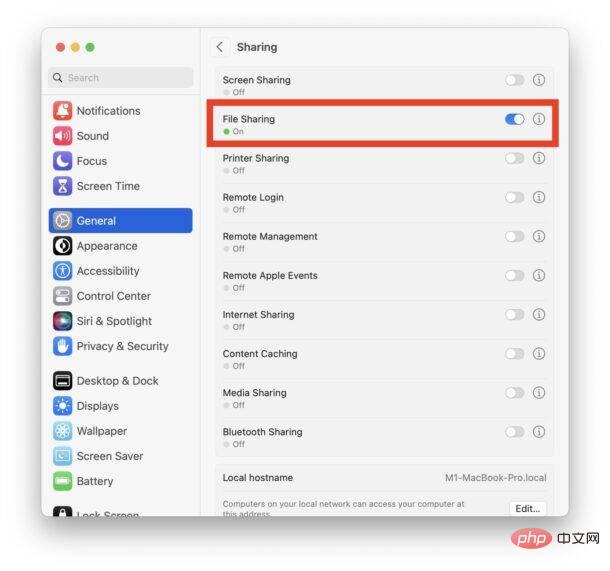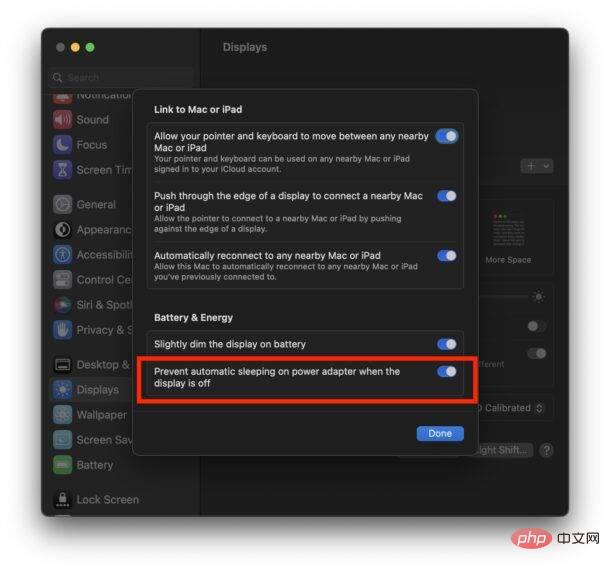php editor Youzi will introduce you to the information files in the Mac system. In Mac systems, an information file is a special file used to store and manage metadata for files and folders. They contain important information about the file, such as creation date, file size, file type, etc. Through information files, users can easily view and edit file properties, as well as search and sort files. Understanding and correctly using information files is an important skill for improving Mac system usage efficiency and managing files. Next, we will introduce you to the relevant knowledge and usage of information files in detail.
macos system setting information is generally stored in format files
The most commonly used MAC OS X file system is HFS, which is a Linux file format and Windows is not compatible with it. When formatting a Mac, you usually choose the MAC OS X extended file system with journaling, which is highly stable and efficient.
sis file generator is a tool for making installers that generate applications. The sis file contains all the information needed to create the installation file. In the Apple system Mac OS X, the common installation package format is pkg, which is similar to the installation program under Windows.
The default download folder for Mac computers is located in the "Downloads" folder, which can be found in the "Finder". Normally, this folder will appear in the sidebar. It is worth mentioning that macOS is an operating system designed specifically for Mac and cannot be installed on ordinary PCs.
The "Mac OS Extended (Journaled)" format file system is the default file system in macOS Sierra and earlier versions. It uses journaling technology to protect file system integrity and provides encryption options to protect disk data.

How to check the basic information of Mac Apple computer
System Preferences: Click the Apple icon in the upper left corner of the screen and select the "About This Mac" option. In the pop-up window, you can see detailed information such as the computer model, processor, memory, storage capacity, etc. Serial Number Lookup: Every Apple laptop has a unique serial number.
First, turn on the computer and enter the desktop. Then, click the Apple icon in the upper left corner and select the "About This Mac" option in the pop-up menu bar. Next, you can view the system overview in the pop-up window.
The steps are as follows: First, turn on the computer and enter the system desktop, click the Apple icon in the upper left corner, and select System Preferences. Next, after entering System Preferences, you can view Mac system version information. Click System Report to enter the system report page. On the system report page, you can view all software and hardware related configuration information.
If you want to check the MacBook configuration, please follow the steps below: First, open the Apple logo in the upper right corner of the homepage. Next, select and click "About This Mac" from the drop-down menu. Then, click on the System Information option. Finally, click More Information to view all hardware information of the system.
First, click the Apple logo in the upper left corner of your Mac desktop and select "About This Mac." In the pop-up window, you can find three configuration information of the Mac computer’s CPU, memory system and graphics card.
How to modify the attribute information of a file in the mac system?
The method is as follows: Open the Word document, find and open the Word document whose attributes you want to modify on macOS, enter the menu, and find it in the menu bar and click on the File menu.
First, select the file whose file name you want to modify, then right-click the mouse and select "Show Introduction". Secondly, in the file's profile information interface, click under the name and extension. Finally, click on the modified file name to modify the file's attribute information using the mac system.
First we open the WPS (word) document and click [File] in the upper left corner. Then a list of options pops up, click [Document Encryption] and select [Properties] to enter. Then we click [OK] in the lower right corner after modifying the document properties. I hope it helps. If you have any questions, please leave a message. Thank you.
How to recover deleted iMessages on Mac?
Method to restore deleted iMessages on Mac from backup Method to use third-party data recovery software to recover deleted or lost iMessages on Mac Download Mac version download Win version How to restore Mac deleted iMessage from backup If you usually have a backup, you can try to restore iMessage from the backup.
The first method is to find that after deleting the file, we did not perform any next operation on the computer. We can directly press Ctrl Z on the keyboard to undo the previous operation, so that the deleted data will automatically return to its original location. .
Method 2: Recover from Time Machine Backup If you are looking for a way to recover deleted files, then first you should use the official pre-installed recovery program on Mac. It is called Time Machine backup and if it is activated, it can easily recover deleted files from Mac.
How to view Mac computer hard disk files and space information
The first step is as shown in the figure below, click on the [Launch Pad] icon on the left. The second step is that in the pop-up window, as shown in the figure below, first click [Others], and then select the [Disk Utility] icon. Finally, in the pop-up window, you can view the hard disk information as shown in the figure below.
Click on the Apple LOGO in the upper left corner of the desktop. In the menu that opens, select the About This Mac option as shown in the figure. In the pop-up window, switch to the storage space option at the top to see the hard disk information. usage.
First turn on the computer, enter the desktop, and click the [Apple] icon in the upper left corner. In the menu that opens, select the [About This Mac] option. As shown in the picture, in the window that opens, switch to the [Storage Space] option at the top and click it.
Where are the system files on the Mac computer?
1. The default download folder of the Mac computer is in the download folder. You can find the folder in the "Finder", which is usually located on the side. Expand knowledge in the sidebar: The macOS system is a dedicated system for Mac. It is an operating system that cannot be installed on an ordinary PC under normal circumstances.
2. Application Folder The application folder is where all the applications installed on your Mac computer are stored. The location of the application folder is as follows: click the Finder icon, "Applications" will be displayed on the left sidebar, click to enter the application folder.
3. Documents On Mac, document files are usually saved in the "Documents" folder, which is located in the user's home directory. You can access this folder from the left sidebar in the Finder, or use Spotlight Search to search to find documents.
Conclusion: The above is a summary of the answers related to mac information files compiled by this site for everyone. I hope it will be helpful to you! If your problem is solved, please share it with more friends who care about this problem~
The above is the detailed content of mac file information. For more information, please follow other related articles on the PHP Chinese website!
 ip与mac绑定什么意思Mar 09, 2023 pm 04:44 PM
ip与mac绑定什么意思Mar 09, 2023 pm 04:44 PMip与mac绑定是指将特定的IP地址与特定的MAC地址关联起来,使得只有使用该MAC地址的设备才能够使用该IP地址进行网络通信。ip与mac绑定可以防止被绑定的主机的IP地址不被假冒,前提条件:1、MAC地址是唯一的,并且不可假冒;只能绑定与路由器直接相连的网络上的主机(也就是主机的网关在路由器上)。
 mac版下载是什么意思Mar 06, 2023 am 09:52 AM
mac版下载是什么意思Mar 06, 2023 am 09:52 AMmac版下载的意思是当软件在选择安装时,选择MAC版下载;Windows版和MAC版是两个不同的操作系统,所以大多数软件在选择安装的同时需要选择Windows版还是MAC版。
 mac鼠标滚轮相反怎么办Mar 16, 2023 pm 05:44 PM
mac鼠标滚轮相反怎么办Mar 16, 2023 pm 05:44 PMmac鼠标滚轮相反的解决办法:1、打开mac电脑,点击屏幕的苹果标志,然后选择“系统偏好设置”;2、在“系统偏好设置”窗口中,选择“鼠标”;3、在“鼠标”窗口中,将“滚动方向:自然”前面的勾去掉即可。
 修复文件共享在 MacOS Ventura 中不起作用Apr 13, 2023 am 11:34 AM
修复文件共享在 MacOS Ventura 中不起作用Apr 13, 2023 am 11:34 AM修复 SMB 文件共享在 MacOS Ventura 中不起作用的问题从 Apple 菜单打开 Mac 上的“系统设置”应用程序转到“常规”,然后转到“共享”找到“文件共享”的开关并将其关闭通过转到 Apple 菜单并选择重新启动来重新启动 Mac重新启动后,返回共享系统设置面板并将“文件共享”重新设置为打开位置像往常一样恢复文件共享,它应该按预期工作如果 MacOS Ventura Mac 与另一台 Mac 或设备之间的文件共享突然再次停止工作,您可能需要在几天后或随机重复此过程。
 如何防止 Mac 在显示器关闭时进入睡眠状态 (MacOS Ventura)Apr 13, 2023 pm 12:31 PM
如何防止 Mac 在显示器关闭时进入睡眠状态 (MacOS Ventura)Apr 13, 2023 pm 12:31 PM显示器关闭时如何防止 Mac 休眠如果您希望 Mac 显示器能够在整个计算机不进入睡眠状态的情况下关闭,请在此处进行适当的设置调整:下拉 Apple 菜单并转到“系统设置”转到“显示”点击“高级...”切换“防止显示器关闭时电源适配器自动休眠”的开关现在 Mac 显示屏可以关闭,同时防止 Mac 本身进入睡眠状态。这可能主要与 Mac 笔记本电脑用户相关,但即使是那些没有 MacBook 的用户也可能会发现该功能很有用。
 mac克隆是什么意思Jan 31, 2023 am 10:33 AM
mac克隆是什么意思Jan 31, 2023 am 10:33 AMmac克隆全称mac地址克隆,是固化在网卡上串行EEPROM中的物理地址,通常有48位长。mac克隆一般应用在路由器上,用户在用电脑直接拨号上网,后来又加了个路由器,通过路由器来实现多台电脑同时上网,这时要用到mac地址克隆了,就是把当前的电脑的mac地址克隆到路由器中去,因为运营商是把你的电脑mac地址绑定你的账号的,所以得克隆以后才能用。
 mac的shift键是哪个键Mar 13, 2023 pm 02:20 PM
mac的shift键是哪个键Mar 13, 2023 pm 02:20 PMmac的shift键是fn键上方、caps lock键下方的一个键,该键在键盘最左侧,由右下往上数第2个键;shift键是键盘中的上档转换键,可以通过“Ctrl+Shift”组合键来切换输入法。
 mac解压rar用什么软件Mar 03, 2023 pm 04:18 PM
mac解压rar用什么软件Mar 03, 2023 pm 04:18 PMmac解压rar的软件:1、The Unarchiver,是一款完全免费、小巧,而且非常易于使用的压缩、解压缩小工具;2、Keka,是一款免费、实用的压缩、解压缩工具,支持解压缩RAR格式的压缩包;3、360压缩大师,是一款免费的压缩、解压缩软件,完全支持RAR文件解压;4、MacZip,支持包括RAR在内的超过20种压缩格式的解压;5、BetterZip;6、FastZip。


Hot AI Tools

Undresser.AI Undress
AI-powered app for creating realistic nude photos

AI Clothes Remover
Online AI tool for removing clothes from photos.

Undress AI Tool
Undress images for free

Clothoff.io
AI clothes remover

AI Hentai Generator
Generate AI Hentai for free.

Hot Article

Hot Tools

Atom editor mac version download
The most popular open source editor

Dreamweaver CS6
Visual web development tools

Safe Exam Browser
Safe Exam Browser is a secure browser environment for taking online exams securely. This software turns any computer into a secure workstation. It controls access to any utility and prevents students from using unauthorized resources.

MantisBT
Mantis is an easy-to-deploy web-based defect tracking tool designed to aid in product defect tracking. It requires PHP, MySQL and a web server. Check out our demo and hosting services.

Zend Studio 13.0.1
Powerful PHP integrated development environment







